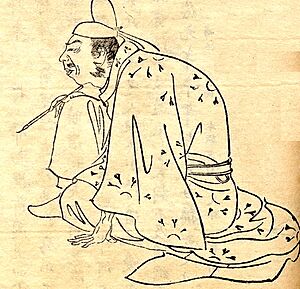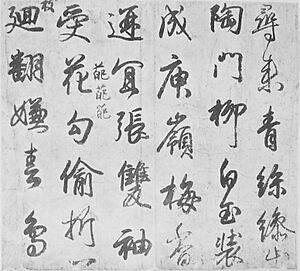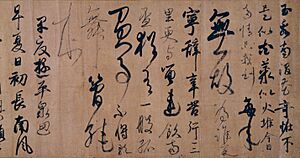Ono no Michikaze facts for kids
Ono no Michikaze (born in 894, died February 9, 966), also known as Ono no Tōfū, was a very famous Japanese calligrapher during the Heian period (794–1185). He is one of the "Three Brush Traces" (called Sanseki in Japanese), along with Fujiwara no Sukemasa and Fujiwara no Yukinari. Michikaze is often seen as the person who started the unique Japanese style of calligraphy, known as wayōshodō. People in Japan even called him the "reincarnation of Wang Xizhi", who was a legendary Chinese calligrapher. He was also sometimes called Yaseki Tōfū.
Contents
Life of Ono no Michikaze
Michikaze was born in what is now Kasugai, Aichi prefecture. His grandfather, Ono no Takamura, was a courtier and a poet. Michikaze himself became a government official, a poet, and, most importantly, a calligrapher. He worked for three emperors during his career: Emperor Daigo (who ruled from 897 to 930), Emperor Suzaku (who ruled from 930 to 946), and Emperor Murakami (who ruled from 946 to 967).
Because of his amazing skill, Michikaze was allowed to serve in the Seiryoden, which was where the emperor lived, when he was just 27 years old. In 927, Emperor Daigo even gave two of Michikaze's calligraphy works to a Buddhist monk named Kanken. The emperor asked Kanken to take them to China to show the Chinese people how great Michikaze's calligraphy was. Michikaze lost a lot of his eyesight by the time he died.
Michikaze's Calligraphy Style
Calligraphy, the art of beautiful writing, came to Japan from China around the 5th century. Michikaze was the first to make it truly Japanese. His style was influenced by the "Two Wangs" (Wang Xizhi and Wang Xianzhi) from China's Eastern Jin period.
Michikaze's writing style, especially his running script, felt softer like the Jin style but still had the strength of the Tang style. He didn't always follow the strict rules of classical Chinese brush techniques, which meant the thickness of his strokes within a single character varied less. These changes helped create the Japanese-style calligraphy, called Wayō (和様). This was different from the Chinese-style calligraphy, called Karayō (唐様). The Wayō style was later made even better by two other masters, Fujiwara no Sukemasa and Fujiwara no Yukinari. Wayō became a recognized and practiced Japanese art form until the mid-19th century.
We don't have any of Michikaze's kana calligraphy (Japanese phonetic script) today. However, many kanji (Chinese characters used in Japanese) works are thought to be his. One famous work, though not completely proven to be his, is a draft for writing on a byoubu (a Japanese folding screen). It's now kept as a handscroll in the Tokyo Imperial Household collection. This work is written in a semi-cursive style and includes ten poems by his friend, Oe no Asatsuna.
The same collection also holds other important works by him, like the Gyokusen-Jo handscroll, which features poems by a Chinese poet from the Tang dynasty. Michikaze is also credited with many kohitsu-gire (famous old calligraphy pieces) from the Heian period. One of these is a scroll with 49 waka poems from the "Poems of Love" section of the Kokin Wakashū, an early Heian poetry collection. Among his last known works are eleven letters, where he sometimes wrote about how short life is.
The Legend of Michikaze and the Frog
Ono no Michikaze became very famous because of a story shown on Hanafuda cards. The story says that one day, Michikaze felt bad about his calligraphy skills. He went for a walk in the rain. He saw a frog trying to jump onto a willow branch, but it kept missing. Michikaze thought, "Silly frog! No matter how many times you try, you'll never reach that branch."
Just then, a strong breeze made the willow branch bend low, and the frog easily jumped onto it. Michikaze then realized, "I'm the silly one! The frog made its own chance with its strong will. I haven't been as determined as this frog." This story made him very popular during the Edo period. It also earned him a spot on the willow set of Hanafuda cards.
Michikaze's Legacy
- On October 20, 2000, Japan issued an 80 yen "Willow and frog" postal stamp. It shows Michikaze watching the leaping frog.
- Hanafuda cards feature Michikaze watching the leaping frog on a card in the November suit. This card is needed to form a special winning combination called Ame-Shikō (Rainy Four Hikari).
- There is a shrine dedicated to Michikaze's spirit in Kyoto. People believe his spirit protects women in the region during pregnancy and childbirth.
See also





